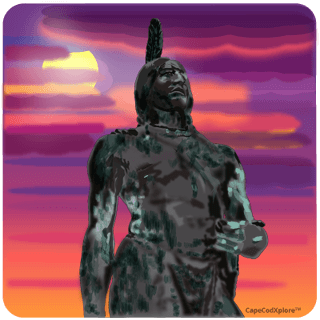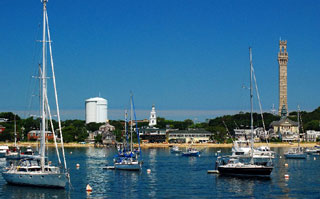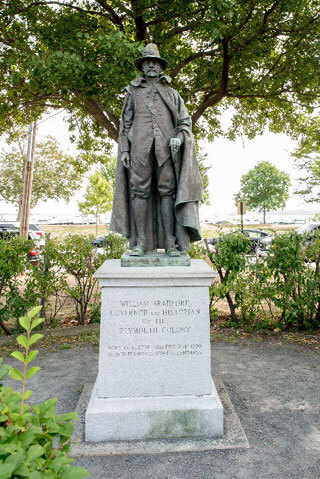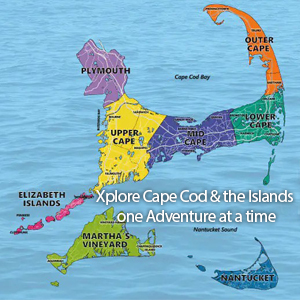Historic Sites
Wampanoag Tribe History on Cape Cod
The Nauset Tribe, which merged with the Wampanoag Tribe several hundred years ago, lived on Cape Cod for thousands of years before English settlers arrived on the Mayflower. The small tribe shared the Massachusetts language and culture with the nearby Wampanoag Tribe, but the larger Wampanoags exercised power over the Nausets throughout their shared history.
on the Mayflower. The small tribe shared the Massachusetts language and culture with the nearby Wampanoag Tribe, but the larger Wampanoags exercised power over the Nausets throughout their shared history.
The Nauset Tribe first contacted English settlers in the early morning of December 7, 1620, when a group of Native Americans from the Nauset Tribe ambushed a search party from the Mayflower on First Encounter Beach in Eastham. According to Governor William Bradford, this was the first encounter between European settlers and Native Americans on Cape Cod.
 The search party survived the ambush and returned to the Mayflower, which was anchored in Provincetown Harbor. During the Mayflower Pilgrims’ first winter in New England, they lived on the ship and survived only on the supplies they’d brought from England and the corn a search party had stolen from the storehouse in a seasonal Nauset village near Provincetown.
The search party survived the ambush and returned to the Mayflower, which was anchored in Provincetown Harbor. During the Mayflower Pilgrims’ first winter in New England, they lived on the ship and survived only on the supplies they’d brought from England and the corn a search party had stolen from the storehouse in a seasonal Nauset village near Provincetown.
While initial contact between the Nausets and the settlers had been hostile, the settlers knew they needed an ally on Cape Cod if they wanted to survive another winter. When the Nauset Tribe returned to Cape Cod in the spring, the settlers repaid the tribe for the stolen corn. Soon after, the Nausets returned an English boy who’d wandered away from Plymouth Colony.
In the coming years, the Nauset Tribe quickly became Plymouth Colony’s closest Native American ally. The alliance was very beneficial for the English settlers, who learned agricultural practices from the Nausets and collaborated with them on projects like the Madaket Ditch. The alliance was also advantageous for the  Nauset Tribe, as it provided opportunities for trade and gave the tribe more power in relation to other Massachusetts tribes like the Wampanoags.
Nauset Tribe, as it provided opportunities for trade and gave the tribe more power in relation to other Massachusetts tribes like the Wampanoags.
Over the decades, the relationship between the Nausets and the settlers remained close. Many members of the Nauset Tribe converted to Christianity and married English settlers. During King Philip’s War (1675-1676) – the last attempt by Native Americans to drive English settlers out of New England – the Nauset Tribe sided with Plymouth Colony against the Wampanoag Tribe.
The Wampanoag Tribe Today
Despite the devastation brought by colonization, the Wampanoag people have survived and continue to live in the region. Today, two federally recognized tribes carry on the traditions of the Wampanoag Nation:
The Mashpee Wampanoag Tribe: Based in Mashpee, on Cape Cod, this tribe is one of the largest groups of Wampanoag people today. They are a vibrant community with cultural, social, and economic programs that sustain their heritage and traditions.
The Wampanoag Tribe of Gay Head (Aquinnah): Based on Martha’s Vineyard, the Aquinnah Wampanoag continue to practice their traditional crafts, fishing, and governance while also participating in modern industry and community life.
Both tribes work to preserve their culture, language, and traditions through initiatives such as language revitalization programs, powwows, and cultural education.
If you’re interested in learning more about the Wampanoag history and culture, the Mashpee Wampanoag Museum offers exhibits on the tribe’s history, artifacts, and culture, and the Plimoth Patuxet Museums (formerly Plimoth Plantation) also provides an in-depth look at Wampanoag life, particularly during the time of first contact with Europeans.
The Wampanoag’s contributions, especially their profound relationship with the land and the sea, continue to be an integral part of Cape Cod’s history and identity.
Today, many places on Cape Cod still bear the names of famous Nausets, although the tribe itself no longer exists. The town of Hyannis and the Wianno historic district, for example, are both named for Nauset chiefs. Other places – like “Nantucket,” “Mashpee,” and “Sagamore” – still bear Massachusetts names that Nausets would have taught English settlers.









